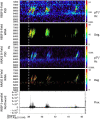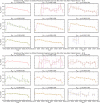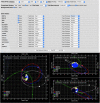Science of the Van Allen Probes Science Operations Centers
- PMID: 36407497
- PMCID: PMC9668807
- DOI: 10.1007/s11214-022-00919-x
Science of the Van Allen Probes Science Operations Centers
Abstract
The Van Allen Probes mission operations materialized through a distributed model in which operational responsibility was divided between the Mission Operations Center (MOC) and separate instrument specific SOCs. The sole MOC handled all aspects of telemetering and receiving tasks as well as certain scientifically relevant ancillary tasks. Each instrument science team developed individual instrument specific SOCs proficient in unique capabilities in support of science data acquisition, data processing, instrument performance, and tools for the instrument team scientists. In parallel activities, project scientists took on the task of providing a significant modeling tool base usable by the instrument science teams and the larger scientific community. With a mission as complex as Van Allen Probes, scientific inquiry occurred due to constant and significant collaboration between the SOCs and in concert with the project science team. Planned cross-instrument coordinated observations resulted in critical discoveries during the seven-year mission. Instrument cross-calibration activities elucidated a more seamless set of data products. Specific topics include post-launch changes and enhancements to the SOCs, discussion of coordination activities between the SOCs, SOC specific analysis software, modeling software provided by the Van Allen Probes project, and a section on lessons learned. One of the most significant lessons learned was the importance of the original decision to implement individual team SOCs providing timely and well-documented instrument data for the NASA Van Allen Probes Mission scientists and the larger magnetospheric and radiation belt scientific community.
Keywords: Data analysis; ECT; EFW; EMFISIS; Magnetosphere; NASA; RBPICE; Ring current; Science operations centers; Space physics; Van Allen probes; Van Allen probes gateway.
© The Author(s) 2022.
Figures











































Similar articles
-
Radiation Belt Storm Probes Ion Composition Experiment (RBSPICE) Revisited: In-Flight Calibrations, Lessons Learned and Scientific Advances.Space Sci Rev. 2023;219(8):80. doi: 10.1007/s11214-023-00991-x. Epub 2023 Nov 28. Space Sci Rev. 2023. PMID: 38037569 Free PMC article. Review.
-
The Relativistic Proton Spectrometer: A Review of Sensor Performance, Applications, and Science.Space Sci Rev. 2023;219(3):26. doi: 10.1007/s11214-023-00962-2. Epub 2023 Apr 5. Space Sci Rev. 2023. PMID: 37034006 Free PMC article. Review.
-
The Electric and Magnetic Fields Instrument Suite and Integrated Science (EMFISIS): Science, Data, and Usage Best Practices.Space Sci Rev. 2023;219(4):28. doi: 10.1007/s11214-023-00973-z. Epub 2023 Apr 25. Space Sci Rev. 2023. PMID: 37123883 Free PMC article. Review.
-
Collaborative Research Activities of the Arase and Van Allen Probes.Space Sci Rev. 2022;218(5):38. doi: 10.1007/s11214-022-00885-4. Epub 2022 Jun 21. Space Sci Rev. 2022. PMID: 35757012 Free PMC article. Review.
-
The ELFIN Mission.Space Sci Rev. 2020;216(5):103. doi: 10.1007/s11214-020-00721-7. Epub 2020 Jul 30. Space Sci Rev. 2020. PMID: 32831412 Free PMC article.
Cited by
-
Radiation Belt Storm Probes Ion Composition Experiment (RBSPICE) Revisited: In-Flight Calibrations, Lessons Learned and Scientific Advances.Space Sci Rev. 2023;219(8):80. doi: 10.1007/s11214-023-00991-x. Epub 2023 Nov 28. Space Sci Rev. 2023. PMID: 38037569 Free PMC article. Review.
References
-
- Acton CH. Ancillary data services of NASA’s navigation and ancillary information facility. Planet Space Sci. 1996;44(1):65–70. doi: 10.1016/0032-0633(95)00107-7. - DOI
-
- Acton CH, Bachman N, Semenov B, Wright E. A look toward the future in the handling of space science mission geometry. Planet Space Sci. 2017;150:9–12. doi: 10.1016/j.pss.2017.02.013. - DOI
-
- Baker DN, Kanekal SG, Hoxie V, Li X, Jaynes AN, Zhao H, et al. The Relativistic Electron-Proton Telescope (REPT) investigation: design, operational properties, and science highlights. Space Sci Rev. 2021;217:68. doi: 10.1007/s11214-021-00838-3. - DOI
-
- Booch G, Jacobson I, Rumbaugh J. The Unified Modeling Language Reference Manual. Boston: Addison Wesley Longman, Inc.; 1999.
Publication types
LinkOut - more resources
Full Text Sources
